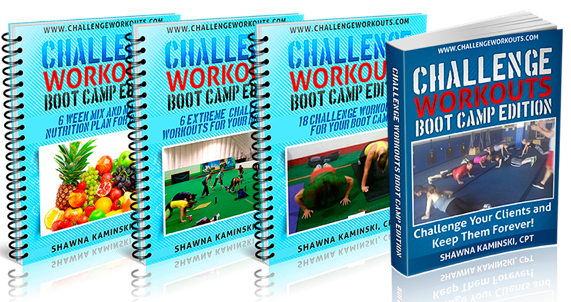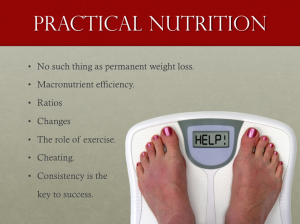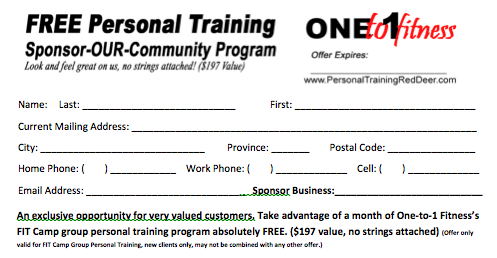The Simple But Critical Key to Managing Varying Fitness Levels in Boot Camp
How do you manage multiple fitness levels in your small groups and boot camps?
 This is one of the biggest challenges fitness trainers have: trying to keep the beginner ‘Mrs. Jones’ motivated and not overwhelmed while challenging the ‘Mrs. Smith’s’ in the group that are seasoned athletes.
This is one of the biggest challenges fitness trainers have: trying to keep the beginner ‘Mrs. Jones’ motivated and not overwhelmed while challenging the ‘Mrs. Smith’s’ in the group that are seasoned athletes.
Do you offer beginner and advanced sessions? The downside of this solution is trying to balance times so that all your clients are happy. It can be a scheduling nightmare.
Wouldn’t it be great if you could have beginner Mrs. Jones training along side the advanced clients like Mrs. Smith? How would that look?
I’m Shawna Kaminski and I run very successful fitness boot camps in Calgary, Alberta. I’ve found some cool ways to solve this issue that I’d like to share with you.
Before going on, I want to make it clear that ALL your clients WANT and expect a challenge in their training. Whether they are just returning to fitness or fitness veterans, they ALL want a challenge. And this is YOUR challenge to deliver this. You don’t want to deflate beginners while having veterans step up their fitness game.
How can you do this?
Your answer? ‘Timed sets’.
Timed sets allows both the grandma’s and the fitness buffs to train together while each person will be challenged at their own level. Clients get tired of counting reps. New-to-fitness people get discouraged when they barely get started when the fitness veteran is already done the reps you prescribe. The veteran says ‘now what?’ and then you have to come up with something else for them to do. Timed sets solve this problem. The veteran will do more work, the beginner will do less, and no one is the wiser as you easily control the session.
Here’s a great challenge workout for your group. You’ll pair strength and cardio sets back to back. Ask your clients to count their reps in the first set and then try to match their reps for each subsequent set. This helps clients create their own challenge and helps them maintain their intensity through the course of the set.
Do 30 seconds of each exercise (strength and then cardio) with a five second transition. So for this set, you can set a timer with a 30/05 repeat for 9 sets:
Weighted squat/Burpee
Push up/mountain climber
Renegade row/squat jump
Bicycle crunch/skater jump
Plank recovery (30 seconds)
Repeat twice more (total of three times through for 15 minutes of sweaty fun)
The beauty of this is that you can modify and intensify exercises easily so everyone is training side by side. Training volume is controlled and everyone gets a great workout. Everyone is set up for success. Reps everyone gets in their first set will be a ‘doable’ challenge for them to try to reach for in subsequent sets.
You can’t compare this to a workout that has a rep scheme where Mrs. Jones when faced with 10 push ups may feel like quitting and Mrs. Smith is done and bored already. If given a 30 second set, Mrs. Jones may do 5 push ups while Mrs. Smith does 15. Also, we all have clients that ‘count by 5’s’ so if your workout is based on counting reps, some get done before some people even start.
Your workout flow is managed so no one is done and waiting and everyone feels successful by getting at least a few reps of each exercise. Everyone gets a balanced workout, since the workout structure and time is controlled. By using timed sets, rep counting is only done for personal accountability and it’s less likely that people will ‘cheat’ since they have to beat or match their own scores.
I’ve been running my own fitness boot camps since 2007 and when surveyed, my clients prefer timed set workouts best. It frees them up to concentrate on exercise form and not on the number of reps they need to do.
I highly recommend using timed sets with your boot camp clients and small groups.
Here’s a short video explaining how timed sets can benefit YOUR boot camp:
[youtube]http://youtu.be/2gMAI4fsuoc[/youtube]
 If you’re looking for challenges for YOUR boot camp, take a look at Challenge Workouts: Boot Camp Edition and see if it’s right for you. You’ll find all kinds of fitness challenges to add to your boot camp to up the excitement and results in your camp.
If you’re looking for challenges for YOUR boot camp, take a look at Challenge Workouts: Boot Camp Edition and see if it’s right for you. You’ll find all kinds of fitness challenges to add to your boot camp to up the excitement and results in your camp.
About Shawna
Shawna Kaminski is a retired schoolteacher of 20 years who’s found her passion in the fitness industry. She’s parlayed her ability to teach and her love of training into programs like her fitness boot camp. Shawna consistently has over 100 clients attend her boot camps monthly. She’s retained many of her clients for nearly a decade. Shawna is in her late forties, is a mother of two teenagers and understands how busy life can be. In addition to running her fitness boot camp, she does online coaching and training as well.




 Do you ever feel overwhelmed in your business? Do you ever feel like maybe it’s just not worth it? Or that it just isn’t going to work?
Do you ever feel overwhelmed in your business? Do you ever feel like maybe it’s just not worth it? Or that it just isn’t going to work?


 Ok this step is really critical and is an absolute powerhouse when it comes to organizations that can bring groups of 10-20 or more people together.
Ok this step is really critical and is an absolute powerhouse when it comes to organizations that can bring groups of 10-20 or more people together. Ok in this step you’re going to re-approach the interviewed experts from step 1.
Ok in this step you’re going to re-approach the interviewed experts from step 1. The Boomer and senior market will be the fastest growing “niche” if you can call the soon to be dominant market a niche in the fitness industry. Boomers are turning 65 every day at an alarming rate! 10,000 every day!! I won’t bore you with stats on how this population segment is exploding, since for this post I want to focus on how small group personal training is very successful currently in our studios for clients over age 55.
The Boomer and senior market will be the fastest growing “niche” if you can call the soon to be dominant market a niche in the fitness industry. Boomers are turning 65 every day at an alarming rate! 10,000 every day!! I won’t bore you with stats on how this population segment is exploding, since for this post I want to focus on how small group personal training is very successful currently in our studios for clients over age 55.
 YES! Contact me today to schedule a FREE no obligation consultation and trial workout.
YES! Contact me today to schedule a FREE no obligation consultation and trial workout.